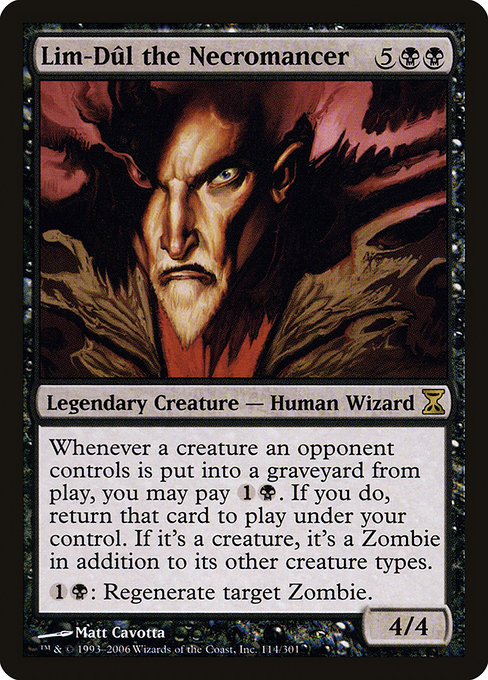
Image courtesy of Scryfall.com
Rarity and mana cost collide in a dramatic way
Limited by design, Magic cards don’t always reveal their true power on the cheap. Lim-Dûl the Necromancer is a pristine example of how rarity and mana cost can align to deliver a late-game punch that feels earned rather than handed to you. With a fearsome {5}{B}{B} mana cost, this legendary Human Wizard lands in the rare tier and invites a longer game where black’s affinity for reanimation and resource denial can shine. The 7-mana spell is not shy about asking for commitment, but the payoff—graveyard-to-battlefield recursion under your control—lands with the gravity of a well-timed finisher. 🧙♂️🔥
What Lim-Dûl does, and why it matters
Let’s parse the key lines and how they shape strategy. When an opponent’s creature dies, you may pay {1}{B}. If you do, that card returns to the battlefield under your control, and if it’s a creature, it blooms into a Zombie with all the associated gloom and grit. That single trigger opens a world of reach, giving you a way to snatch back threats or convert fallen foes into minions. The second ability—{1}{B}: Regenerate target Zombie—adds a resilient edge, letting you defend your newly raised forces against removal and combat tricks. It’s a layering of tempo risk and late-game inevitability. ⚔️🎲
- Trigger-centric reanimation: Opponent-fall triggers create opportunities to reanimate their fallen creatures under your control.
- Zombie upside: If the returned card is a creature, you gain a Zombie on your side—perfect for tribal synergies or attrition strategies.
- Defensive redundancy: Regenerating Zombies helps you weather sweep winds and keep your board intact through the midgame.)
That trio of elements—delayed payoff, aggressive undead synergy, and built-in protection—defines Lim-Dûl as a card that rewards patient play and precise timing. It’s not a bolt to the face; it’s a long game, where every resurrected creature tilts the board toward your favor. The design leans into the black ethos of turning death into momentum, and the veteran feel of Time Spiral’s era adds a narrative flavor that fans recognize in both art and mechanics. 🧟♂️💎
Gameplay implications: how to leverage a high-cost rare
In practice, Lim-Dûl belongs in decks that can safely invest in the late stages of a match. Aristocrats and reanimator shells love the texture: you weaponize their own creatures against them, then reclaim value with each reanimated body. The card’s mana value of seven is a clear signal: you’re playing for resilience and inevitability rather than immediate dominance. Pair it with ramp or identity-fusing effects that smooth the path to seven, and you’ll unlock a sequence where one well-timed recursion swing can redefine the board state. And yes, it pairs perfectly with a few well-placed zombie synergies to maximize the payoff. 🧙♂️🔥
The Time Spiral frame and lore highlight a magical world where plans unfold at a measured pace. The necromancer’s explicit promise—bring back a creature to fight once more—fits neatly with black’s tradition of reanimation costs paid in life, mana, and patience. For players who love long grindy games, Lim-Dûl offers a satisfying arc: you invest, you wait, you recover, and you gain the edge as your opponents tire. It’s the kind of card that makes a late-game draw feel earned, not lucky. 💀🎨
Design signals: rarity as a balancing lever
Rarity isn’t just about scarcity; it’s a message about power and risk. Lim-Dûl’s rare status communicates that its formidable reanimation engine is not something you should expect to deploy at a casual pace. The high mana cost acts as a gate, ensuring only decks with a robust mana base or reliable acceleration can reliably reach the payoff. The result is a design that respects both the thrill of discovery (a rare in a 2006-era set) and the practicality players face in constructed play. The card’s enduring interest—aside from the quirky zombie twist—is the way it invites a flexible, multi-turn plan that can pivot based on the battlefield’s flux. 🧠🎯
Collector value and the backdrop of Time Spiral
In the broader Magic landscape, Time Spiral era cards live in a sweet spot that collectors adore: classic art, a dash of time-warped flavor, and a power curve that remains relevant in formats that matter. Lim-Dûl’s rarity is part of its charm, and its price reflects a mix of nostalgia and practical value. The listed prices—a few dollars for non-foil, up to a modest welcome for foil—underscore that this card is accessible to many collectors while still holding a place in thematic zombie or reanimator decks. It’s the kind of piece that sits at the crossroads of playability and collectibility, a little treasure for the long-game thinker. 🧩💎
As you weigh the balance of rarity and mana cost, Lim-Dûl the Necromancer remains a vivid case study: an expensive spell with a redirect of your opponent’s forces, a sculpted zombie theme, and a design that rewards patient, strategic play. It’s a reminder that value in MTG isn’t just about the fastest clock—it’s about the story, the timing, and the unforgettable moments when a back-from-the-dead threat flips the table. 🧙♂️🎲
Clear Silicone Phone Case Slim Flexible ProtectionMore from our network
- https://crypto-acolytes.xyz/blog/post/solana-meme-melania-on-chain-trend-shows-large-community-thin-liquidity/
- https://blog.digital-vault.xyz/blog/post/understanding-user-behavior-heatmaps-as-your-design-compass/
- https://blog.digital-vault.xyz/blog/post/flash-foliage-cosplay-from-card-art-to-costume/
- https://blog.digital-vault.xyz/blog/post/content-marketing-for-digital-creators-to-grow-audiences/
- https://blog.digital-vault.xyz/blog/post/tor-wauki-and-the-multiverse-strategizing-mtgs-big-events/